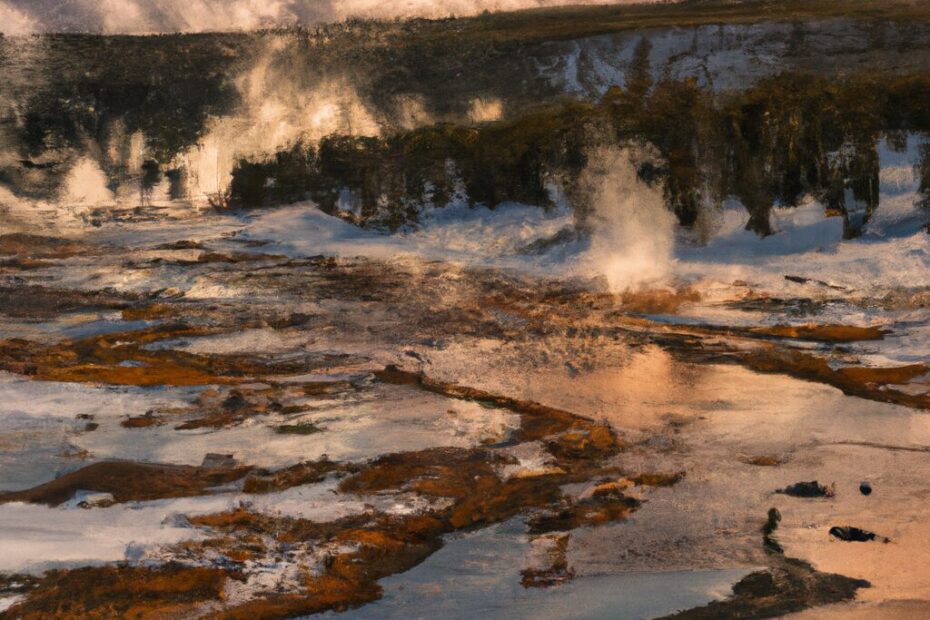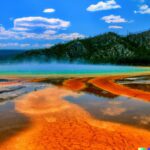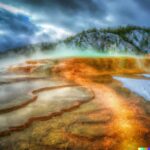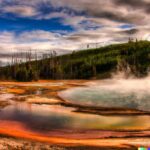Yellowstone National Park is home to some of the most captivating natural wonders on Earth, including its iconic geysers.
In this article, we will explore the fascinating geology of Yellowstone geysers, from the role of magma in their eruptions to the different types of geysers found in the park.
We will also delve into the formation and evolution of these hydrothermal features, as well as their history and potential future in the face of climate change.
Join us on a journey through the mesmerizing world of Yellowstone’s geysers and uncover the secrets of their captivating eruptions.
What Causes Geysers to Erupt?
The eruption of geysers, especially in the context of Yellowstone’s geology, is a spectacular manifestation of volcanic and geothermal activity, driven by the intricate workings of the geothermal reservoir beneath the surface.
The unique geology of Yellowstone, characterized by its hot spot and the presence of a large caldera, creates an ideal environment for the formation of geysers.
The interplay of volcanic and geothermal activities in this region results in the accumulation of heat and pressure within the geothermal reservoirs, eventually leading to the dramatic eruptions that captivate visitors and researchers alike.
Understanding the underlying geological and geothermal processes is crucial for comprehending the mesmerizing behavior of geysers in this remarkable natural setting.
What is the Role of Magma in Geyser Eruptions?
The role of magma in geyser eruptions, particularly within the geological context of Yellowstone, is pivotal as it influences the dynamics of volcanic and geothermal activities, shaping the behavior and frequency of geyser eruptions in this unique geologic setting.
Magma plays a crucial role in the formation and maintenance of the geothermal reservoir that underlies Yellowstone. Its interaction with the geothermal system generates the heat and pressure necessary for geyser eruptions.
The presence of magma beneath the Earth’s surface can trigger volcanic activity, further impacting the behavior of geysers. Understanding this complex interplay of magma, geothermal reservoir, and volcanic activity is essential in comprehending the distinct geyser behavior witnessed in Yellowstone National Park.
The Geology of Yellowstone National Park
The geology of Yellowstone National Park is a captivating tapestry of diverse geothermal features, thermal pools, and mesmerizing geologic formations, showcasing the rich complexity of this unique geothermal area.
Yellowstone National Park boasts a unique landscape, shaped by its location over a volcanic hot spot. This has resulted in the creation of famous geysers like Old Faithful and vibrant hot springs such as Grand Prismatic Spring.
But the park’s features don’t stop there. It also includes stunning canyons, powerful waterfalls, and the massive Yellowstone Caldera – a supervolcano that has been shaping the land for thousands of years. With a diverse range of geological formations, from volcanic rocks to fossil forests, Yellowstone offers a captivating glimpse into the Earth’s ever-changing processes and natural history.
What is the Yellowstone Caldera?
The Yellowstone Caldera, a prominent geological feature within Yellowstone’s landscape, represents a colossal volcanic crater formed by past eruptions, and it continues to influence the park’s remarkable geothermal features and thermal formations.
Yellowstone National Park’s iconic caldera, formed approximately 640,000 years ago, was a result of a massive volcanic eruption that caused the land to collapse. This caldera is responsible for the park’s geothermal wonders, such as geysers, hot springs, and fumaroles. Ongoing volcanic activity beneath the surface continues to shape Yellowstone’s unique geological formations and offers scientists valuable insights into the Earth’s geologic processes.
What are the Different Types of Geysers in Yellowstone?
Yellowstone National Park is home to a variety of geysers, each with its own unique characteristics. From the towering eruptions of the famous Old Faithful to the delicate formations of smaller geysers like the Beehive, these natural wonders never cease to amaze.
The surfaces of many geysers are adorned with geyserite deposits, evidence of the ongoing geothermal processes that have shaped them over centuries. The geology of Yellowstone, with its underground magma reservoir and hydrothermal circulation, creates the perfect conditions for the diverse range of geysers found within the park. These natural wonders are a testament to the powerful forces at work beneath the Earth’s surface.
How do Geysers Form and Evolve in Yellowstone?
The formation and evolution of geysers in Yellowstone are intricately linked to the dynamic interplay of geothermal energy, thermal vents, and the underlying hydrothermal system, shaping the mesmerizing spectacle of geyser activity within the park’s geologic tapestry.
Geothermal energy, sourced from the Earth’s core, serves as the primary driving force behind the formation of geysers. As underground water comes into contact with the scorching temperatures of the earth’s mantle, it becomes heated and pressurized.
This superheated water then rises through fissures in the rock, finding its way to the surface through a network of thermal vents. The hydrothermal system, with its intricate network of channels and reservoirs, further amplifies the conditions necessary for the development of geysers, creating a remarkable display of nature’s geologic marvels.
The Role of Hydrothermal Features in Yellowstone Geysers
Hydrothermal features play a pivotal role in shaping the mesmerizing geysers and thermal pools of Yellowstone, reflecting the enthralling dynamics of hydrothermal activity within the park’s geologic landscape.
Their influence is evident in the diverse colorations and mineral deposits found in the thermal pools, creating a striking visual display.
The intricate network of underground hot springs and vents, fueled by geothermal energy, is responsible for the bubbling and hissing sounds that add to the otherworldly ambiance of the geysers.
These features showcase the power and beauty of nature, offering visitors a glimpse into the captivating interplay between geology and hydrothermal processes.
What is the Hotspot Theory?
The Hotspot Theory, pivotal in understanding the geologic history of Yellowstone, proposes that a mantle plume beneath the Earth’s crust is responsible for the region’s intense tectonic activity and the geological marvels that define the park’s captivating history.
This theory suggests that the plume has led to the creation of the Yellowstone Caldera, one of the largest supervolcanoes in the world, and the countless geothermal features such as geysers and hot springs that make Yellowstone unique.
The hotspot theory accentuates the dynamic nature of the park’s landscape, revealing how its geological formations have evolved over millions of years due to the underlying forces of tectonic activity. The intricate interplay between the hotspot and the Earth’s crust has molded the enigmatic past of Yellowstone, leaving a legacy of geological wonders waiting to be explored.
How do Hydrothermal Features Create Geysers in Yellowstone?
The process through which hydrothermal features create geysers in Yellowstone involves the intricate interaction of geothermal activity, sedimentary rocks, and geological processes, culminating in the formation of the park’s captivating geologic marvels.
Yellowstone National Park is home to a unique and breathtaking array of hydrothermal features, such as hot springs and fumaroles. These natural wonders are a result of geothermal heat from the earth’s crust, where water seeps into the ground and gets heated by the geothermal activity. As pressure builds up, it leads to spectacular eruptions in the form of geysers.
The presence of sedimentary rocks plays a crucial role in this process, providing porous and fractured pathways for the heated water to percolate through. This further enhances the geological activity, resulting in the stunning features that we see today. These geological processes have been at work for thousands of years, shaping Yellowstone’s landscape and leaving visitors in awe of nature’s remarkable creations.
The History and Future of Yellowstone Geysers
The history and future of Yellowstone geysers are deeply intertwined with the evolving geological features of the park, while the looming impact of climate change raises compelling questions about the sustainability of these natural marvels.
Over centuries, the geysers in Yellowstone have shaped the landscape and captured the fascination of visitors worldwide. Their formation is a showcase of the Earth’s dynamic processes, as they rely on the interaction of water and heat deep within the Earth’s crust.
With the specter of climate change, concerns about the alteration of underground hydrothermal systems and potential changes in geyser activity have emerged. These changes could have significant implications for the future of these iconic geysers and the overall ecological balance in Yellowstone National Park.
What is the History of Geysers in Yellowstone?
The riveting history of geysers in Yellowstone weaves a tale of geologic marvels, characterized by the enduring influence of geothermal activity and the captivating formations that define the park’s enthralling landscape.
Yellowstone National Park boasts awe-inspiring features that have been shaped over thousands of years. The continuous geothermal processes have created a dynamic and ever-changing environment, making it a living testament to the earth’s immense power.
The geological tapestry of Yellowstone offers visitors a glimpse into the raw and untamed beauty of nature. It is a coalescence of various forces that have gifted the park with its stunning landscapes. This legacy of geologic wonders not only showcases the forces that have shaped the land but also highlights the ongoing processes that continue to mold and transform the park’s geologic canvas.
How Might Climate Change Affect Yellowstone Geysers?
The potential impact of climate change on Yellowstone’s geysers raises important considerations about the resilience of the park’s thermal waters and the enduring influence of geothermal activity amidst the changing environmental dynamics.
These unique thermal features of Yellowstone National Park have been shaped by geothermal forces over many millennia. This delicate balance is now facing the challenges of a rapidly changing climate.
The threat of altered precipitation patterns, rising temperatures, and shifting hydrological cycles could potentially disrupt the fragile equilibrium of these geysers. The park’s adaptive capacity and continued research efforts provide hope for the preservation of these natural wonders amidst evolving environmental conditions.
Frequently Asked Questions
What is the geology behind the famous geysers in Yellowstone?
The geology of Yellowstone National Park plays a crucial role in the formation of its iconic geysers. The park sits atop a massive volcanic hotspot, with molten magma just a few miles below the surface. This heat source, along with the park’s unique geology, creates the perfect conditions for geysers to form.
How are geysers formed in Yellowstone?
Yellowstone’s geysers are formed when superheated water from the underground magma chamber rises to the surface through cracks and fissures in the earth’s crust. As the water reaches the colder surface, it quickly turns to steam and erupts, creating the iconic geyser displays we all know and love.
What is the role of silica in Yellowstone’s geysers?
Silica is a mineral that is found in high concentrations in the water in Yellowstone’s geysers. This mineral helps to form the distinct cone shapes of the geysers by creating a layer of hard, colorful sediment on the outside. Silica also helps to regulate the temperature of the water, allowing it to build up pressure and eventually erupt.
Why are the geysers in Yellowstone so predictable?
The geysers in Yellowstone are known for their impressive predictability, with some erupting at regular intervals. This is due to the unique geology of the park, where the underground plumbing system of the geysers is connected to a large underground reservoir of water. As the water in the reservoir heats up, it builds up pressure and causes the geyser to erupt at regular intervals.
What is the connection between Yellowstone’s geysers and earthquakes?
Yellowstone is located in an active seismic zone, with small earthquakes occurring frequently. These seismic activities can have an impact on the geysers, causing changes in their eruption patterns and even leading to new geyser formations. Scientists closely monitor these earthquakes to better understand the behavior of the geysers.
How many geysers are there in Yellowstone National Park?
While there are countless hot springs and other thermal features in Yellowstone, there are only around 500 geysers in the park. Of these, only about 10% are considered major geysers, with regular and predictable eruptions. However, there are still many unexplored areas of the park that may contain undiscovered geysers waiting to be found.
Last Updated on January 25, 2024 by Jon Waraas – Originally Posted: January 25, 2024

I’m Jon Waraas, and I’ve been navigating the online world since 2006. By day, I’m the proud owner of some eCommerce gems, and by night, I’m the voice behind the adventures on Waraas.Com.
My heart, however, belongs to the wild beauty of Yellowstone National Park. I’ve got a collection of websites dedicated to sharing the wonders of this natural masterpiece. Oh, and did I mention? I’m currently building my own cabin inside the ghost town of Gilmore, Idaho – a cabin with tales to tell!
When I’m not immersed in the digital realm, you’ll find me lacing up my boots for a good hike or setting up camp under the star-studded sky.




